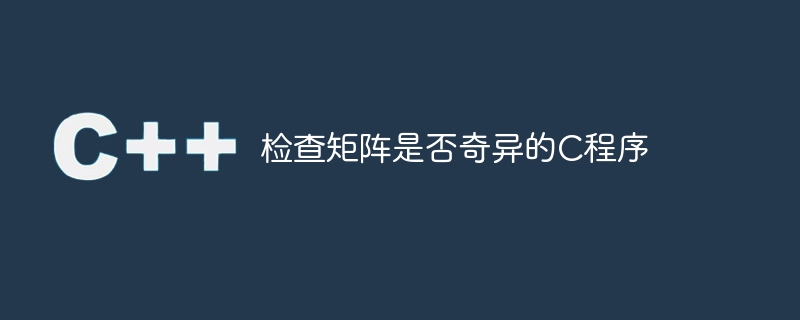Home >Backend Development >C++ >C program to check if matrix is singular
C program to check if matrix is singular
- WBOYWBOYWBOYWBOYWBOYWBOYWBOYWBOYWBOYWBOYWBOYWBOYWBforward
- 2023-08-25 23:09:061593browse

Given a matrix mat[row][column], our task is to check whether the given matrix is singular through a function and display the result.
A singular matrix is a matrix whose determinant is zero. If the determinant is not zero, the matrix is non-singular.
So, to determine whether the matrix is singular or non-singular, we need to first calculate the determinant. The determinant of the matrix can be calculated as -
$$M1[3][3]\:=\:\begin{bmatrix}a & b & c \d & e & f \g & h & i \end{bmatrix}$$
|m1| = a(e*i - f*h) - b(d*i - f*g) c(d*h - e*g)
Example
Input-: mat[3][3]= { 4, 10, 1 },
{ 0, 2, 3 },
{ 1, 4, -3 }
Output-: matrix is non-singular
Input-: mat[3][3]= { 0, 0, 0 },
{ 10, 20, 30 },
{ 1, 4, -3 }
Output-: matrix is singular
Since the entire first row is 0 the determinant will be zero onlyAlgorithm
Start
In function cofactor(int matrix[N][N], int matrix2[N][N], int p, int q, int n)
{
Step 1-> Declare and initialize i = 0, j = 0, row, col
Step 2-> Loop For row = 0 and row < n and row++
Loop For col = 0 and col < n and col++
If row != p && col != q then,
Set matrix2[i][j++] as matrix[row][col]
If j == n – 1 then,
Set j = 0
Increment i by 1
End for
End for
In function int check_singular(int matrix[N][N], int n)
Step 1-> Declare and initialize int D = 0;
Step 2-> If n == 1 then,
Return matrix[0][0]
Step 3-> Declare matrix2[N][N], sign = 1
Step 4-> Loop For f = 0 and f < n and f++
Call function cofactor(matrix, matrix2, 0, f, n)
Set D += sign * matrix[0][f] * check_singular(matrix2, n - 1)
Set sign = -sign
End loop
Step 5-> Return D
In main()
Step 1-> Declare and initialize a matrix[N][N]
Step 2-> If call check_singular(matrix, N) returns non 0 value then,
Print "Matrix is Singular "
Step 3-> Else
Print "Matrix is non-Singular "
StopExample
Real-time demonstration
#include <stdio.h>
#define N 4
//to find the cofactors
int cofactor(int matrix[N][N], int matrix2[N][N], int p, int q, int n) {
int i = 0, j = 0;
int row, col;
// Looping for each element of the matrix
for (row = 0; row < n; row++) {
for (col = 0; col < n; col++) {
// Copying into temporary matrix only
// those element which are not in given
// row and column
if (row != p && col != q) {
matrix2[i][j++] = matrix[row][col];
// Row is filled, so increase row
// index and reset col index
if (j == n - 1) {
j = 0;
i++;
}
}
}
}
return 0;
}
/* Recursive function to check if matrix[][] is singular or not. */
int check_singular(int matrix[N][N], int n) {
int D = 0; // Initialize result
// Base case : if matrix contains single element
if (n == 1)
return matrix[0][0];
int matrix2[N][N]; // To store cofactors
int sign = 1; // To store sign multiplier
// Iterate for each element of first row
for (int f = 0; f < n; f++) {
// Getting Cofactor of matrix[0][f]
cofactor(matrix, matrix2, 0, f, n);
D += sign * matrix[0][f] * check_singular(matrix2, n - 1);
// terms are to be added with alternate sign
sign = -sign;
}
return D;
}
// Driver program to test above functions
int main() {
int matrix[N][N] = { { 4, 10, 1 },
{ 0, 2, 3 },
{ 1, 4, -3 } };
if (check_singular(matrix, N))
printf("Matrix is Singular</p><p>");
else
printf("Matrix is non-Singular</p><p>");
return 0;
}Output
If you run the above code, it The following output will be generated -
Matrix is non-Singular
The above is the detailed content of C program to check if matrix is singular. For more information, please follow other related articles on the PHP Chinese website!

